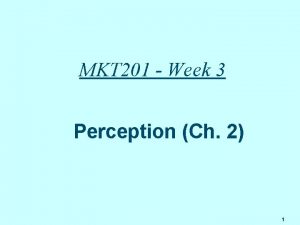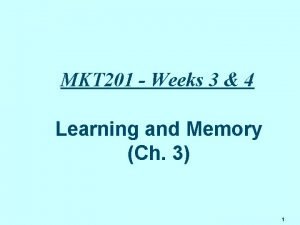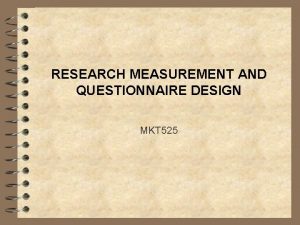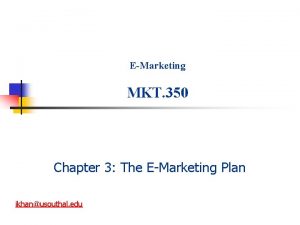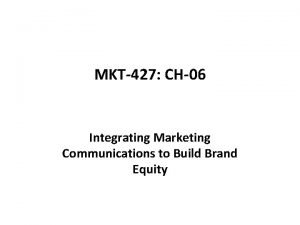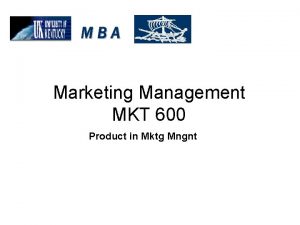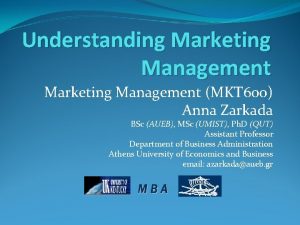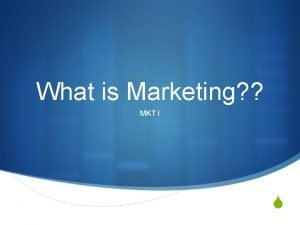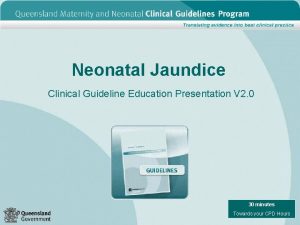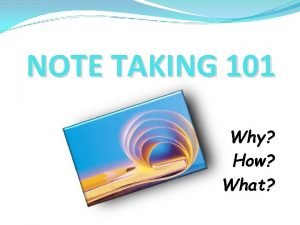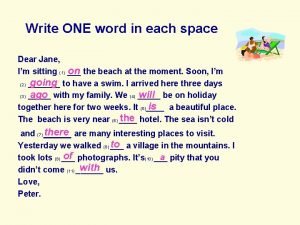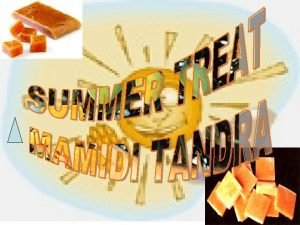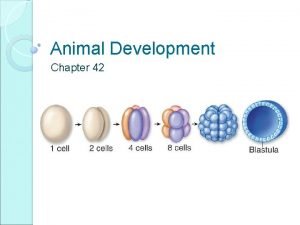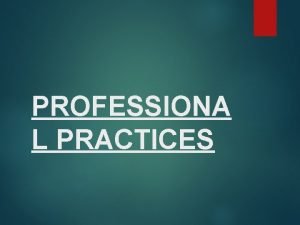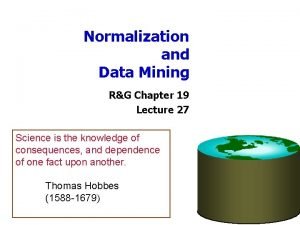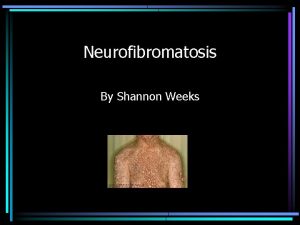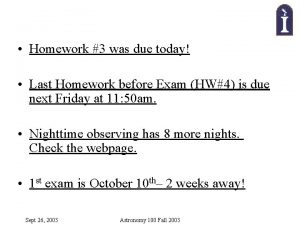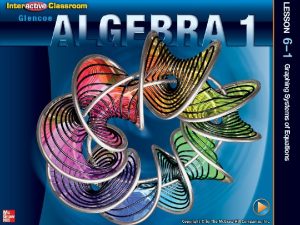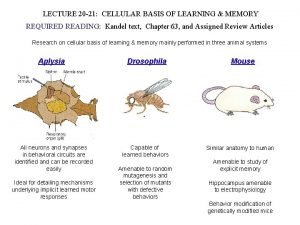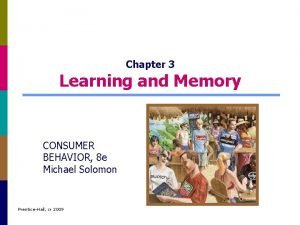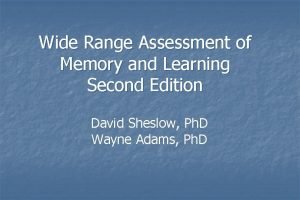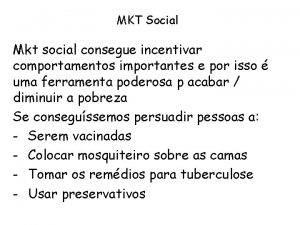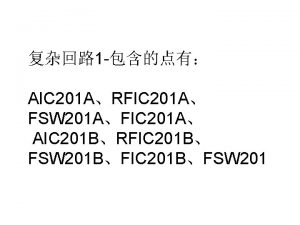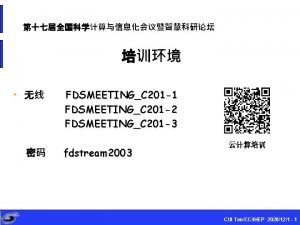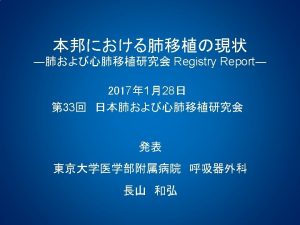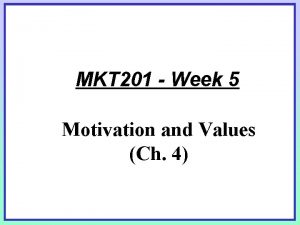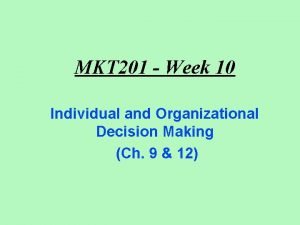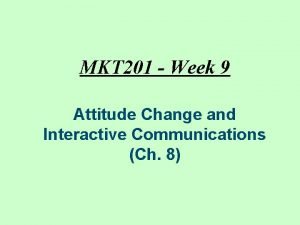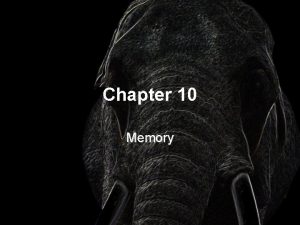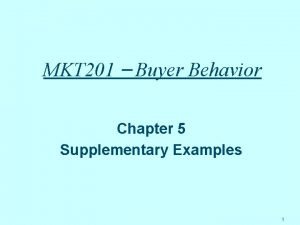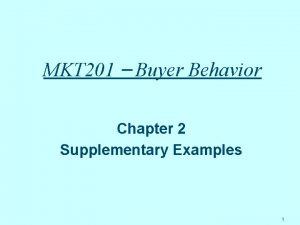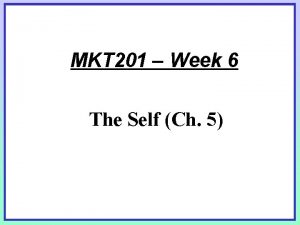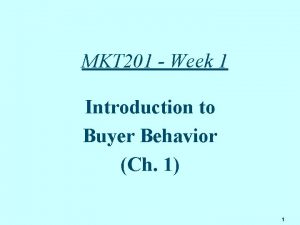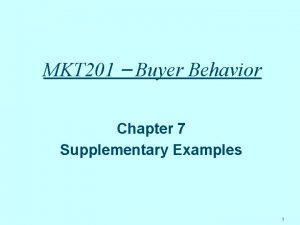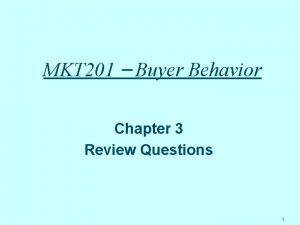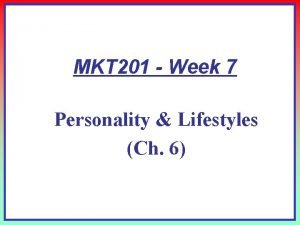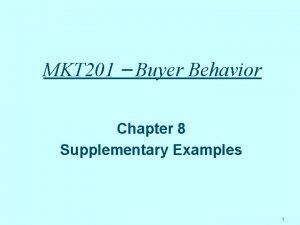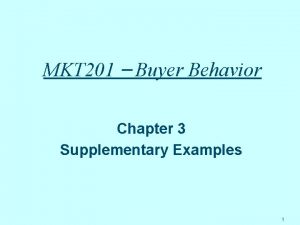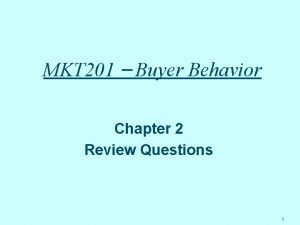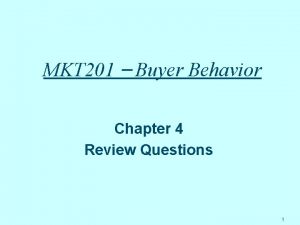MKT 201 Weeks 3 4 Learning and Memory



















































- Slides: 51

MKT 201 - Weeks 3 & 4 Learning and Memory (Ch. 3) 1

The Learning Process • Learning: – A relatively permanent change in behavior caused by experience • Learning is an Ongoing Process and we can learn: – Vicariously by observing events that affect others (don’t need direct experience) – By incidental learning which is unintentional (can hum product jingles, without using the product) * There are several theories to explain the learning process, such as the Behavioral Theory and the Cognitive Theory 2

Learning is a Process • Our tastes are formed as a result of a learning process, sometimes with painful results. 3

(1) BEHAVIORAL LEARNING THEORIES (stress on stimulus-response connection) Two Major Approaches: (a) Classical Conditioning » Ivan Pavlov (Russian physiologist) (b) Instrumental Conditioning (Operant Conditioning) 4

Behavioral Learning Theories • Assume that learning takes place as the result of responses to external events. • View is represented by two major approaches to learning: – 1) Classical Conditioning – 2) Instrumental Conditioning • People’s experiences shaped by feedback they receive as they go through life • Actions result in rewards and punishments, which influences future responses to similar situations. 5

Behavioral Learning Theories Assume that Learning Takes Place as the Result of Responses to External Events (NOT focus on internal thought processes). Stimulus Consumer Response Consumer’s Black Box 6

Behavioral Learning Theory: (a) Classical Conditioning Occurs When a Stimulus That Elicits a Response is Paired With Another Stimulus That Initially Does Not Elicit a Response on It’s Own. Unconditioned Stimulus (UCS) Conditioned Stimulus (CS) Conditioned Response (CR) meat powder bell salivate Ivan Pavlov’s experiment on dogs 7

Behavioral Learning Theory: (a) Classical Conditioning Occurs When a Stimulus That Elicits a Response is Paired With Another Stimulus That Initially Does Not Elicit a Response on It’s Own. Repeated Pairing Unconditioned Stimulus (UCS) Conditioned Stimulus (CS) Conditioned Response (CR) meat powder bell salivate Visual cues, Olfactory cues A brand name / product; Sexual arousal, huger, thirst, other basic drives 8

Classical Conditioning • Ivan Pavlov’s Dogs – Unconditioned stimulus (UCS) – Naturally capable of causing a response. – Conditioned stimulus (CS) – Does not initially cause a response – Conditioned response (CR) – Response generated by repeated paired exposures to UCS and CS. Eventually, through learned association and repetition, the CS will cause the CR. 9

Factors That Affect the Classical Conditioning Process (1) Repetition (CS paired with UCS, repeated exposure increase the strength) (2) Stimulus Generalization (react to similar conditioned stimuli CS with similar responses) (3) Stimulus Discrimination (similar CS not followed by a UCS, so original manufacturers urge consumers not to buy “cheap imitations”) 10

(1) Repetition of exposure – – Type of medium used (and frequency/interval) affect the effectiveness Extinction (as CS is only occasionally paried with the UCS -> conditioning will not occur)) • – Izod Lacoste crocodile on baby clothes Beware of… • • Advertising wearout Frequent product encounters 11

Discussion Question • In the 1980’s, the Lacoste crocodile was an exclusive logo symbolizing casual elegance. When it was repeated on baby clothes and other items, it lost its cache and began to be replaced by contenders such as the Ralph Lauren Polo Player. • Can you thing of other logos that have lost their prestige due to repetition? 12

Classical Conditioning in Advertising • This American Airlines ad points to classical conditioning as an explanation for why their AAdvantage Marketing Programs (travel awards programs) will work. • Can you identify the UCS, and the CR in this example? 13

(2) Stimulus Generalization – Halo effect (react similarly to similar stimulus) • “Piggybacking” strategy (producing me-too products) • Masked branding (Levi’s markets its Red Tab) – Family branding, product line extensions, licensing, look-alike packaging 14

Masked Branding Levi’s markets its Red Tab targeting to younger customers (who don’t like “old” brand) Plank Road Brewery: Icehouse beer 15

(3) Stimulus Discrimination – Brand positioning • Unique attributes of brand – Anti-Counterfeiting Coalition combats “knockoffs” (unauthorized copy) CONSUMERS’ DISCRIMINATION FOR PROCTER & GAMBLE’S PACKAGING/LABELING 16

Marketing Applications of Behavior Learning Principles • Brand Equity: – A brand has strong positive associations in a consumer’s memory and commands loyalty. • Applications of Repetition (avoid advertising wearout) • Applications of Conditioned Product Associations : – Semantic associations (meaning of words/language) – Phonemes (smallest phonetic unit in a language that is capable of conveying a distinction in meaning) (pleasant music, humor, … with the product) 17

Loyalty to Brands • Rewarding consumers with frequent flyer miles is an effective way to reinforce them and build brand loyalty. 18

Marketing Applications of Behavior Learning Principles (cont’d) • Applications of Stimulus Generalization: – Family branding – Product line extensions – Licensing – Look-alike packaging • Applications of Stimulus Discrimination: – Consumers learn to differentiate a brand from its competitors – Unique attributes of the brand 19

Beware of Knockoffs (imitation) 20

Behavioral Learning Theory: (b) Instrumental Conditioning (Operant Conditioning) Occurs as the Individual Learns to Perform Behaviors That Produce Positive Outcomes and to Avoid Those That Yield Negative Outcomes. It Occurs in One of the Following Three Ways: Positive Reinforcement Negative Reinforcement Punishment 21

Four Types of Reinforcement Try to use perfume as examples Figure 3. 2 22

Instrumental Conditioning • Reinforcement Schedules (trying to reward consumers to condition desired behaviour) Ø Fixed-interval reinforcement (seasonal sales – fixed time period) Ø Variable-interval reinforcement (not knowing the exact time of reinforcement; secret shoppers for testing service quality) Ø Fixed – Ratio reinforcement (grocery-shopping receipt programs, collection of 10 trading stamps – fixed no. of responses) Ø Variable – Ratio reinforcement (slot machine) 23

Applications of Instrumental Conditioning Principles • Reinforcement of Consumption: – Simple “Thank you” – Rebates – Follow-up phone calls • Frequency Marketing (a popular technique): – Reinforces regular purchases by giving them rewards with values that increase along with the amount purchased • Frequent flyer miles 24

(2) COGNITIVE LEARNING THEORY • Stress on the importance of internal mental process • View people as problem solvers with the use of information • Is learning cognitive/conscious or not? Behavioural learning theory - automatic nature of conditioning: no, not conscious Cognitive learning theory: yes, react to a stimulus consciously – Trigger feature • A stimulus that cues an individual toward a particular pattern and activates a reaction e. g. seductive woman (trigger feature) in an ad for a car -> better rating 25

Cognitive Learning Theory: Observational Learning Occurs When People Watch the Actions of Others and Note the Reinforcements They Receive From Others. Imitating the Behavior of Others is Called Modeling: Modeling Consumer’s Attention Must Be Drawn to a Desirable Model Consumer Must Remember What is Said and Done by Model Consumer Must Convert This Information Into Actions Consumer Must be Motivated to Perform These Actions 26

Components of Observational Learning Figure 3. 3 27

Applications of Cognitive Learning Principles • Consumers learn vicariously by seeing others receive reinforcement for their behaviors. • Marketers can reinforce or punish consumers indirectly by showing what happens to desirable models who do or do not use their products. • Consumers’ evaluations of models are not limited to stimulus-response connections. – Attractiveness can be based on several components (e. g. physical attractiveness, expertise, similarity to the evaluator) 28

The Role of Memory in Learning • Memory – A process of acquiring and storing information such that it will be available when needed. • Stages of Memory – Encoding stage • Information entered in a recognizable way – Storage stage • Knowledge integrated into what is already there and warehoused – Retrieval stage • The person accesses the desired information 29

The Memory Process Figure 3. 4 30

Memory and Advertising This Brazilian ad illustrates that external memory aids like Post-Its can help us to remember many of the details of modern life. 31

Encoding Information for Later Retrieval • Types of meaning: – Sensory meaning (e. g. color or shape) – Sense of familiarity (e. g. seeing a food that we have tasted) – Semantic meaning: Symbolic associations (e. g. rich people drink champagne) (Semantics – also refers to the aspects of meaning that are expressed in a language, code, or other form of representation. ) (Semiotics - the study of signs and symbols, both individually and grouped in sign systems. ) • Personal relevance: – Episodic memories: Relate to events that are personally relevant – Flashbulb memories: Especially vivid associations – Narrative: An effective way of persuading people to construct a mental representation of the information that they are viewing 32

Memory Systems 1. Sensory Memory: – Very temporary storage of information we receive from our senses 2. Short-Term Memory (STM): – – Limited period of time & limited capacity Working memory (i. e. , holds memory we are currently processing) 3. Long-Term Memory (LTM): – – Can retain information for a long period of time Elaboration rehearsal is required: Process involves thinking about a stimulus and relating it to information already in memory 33

Storing Information in Memory Activation Models of Memory Short-Term and Long-Term Memory are Interdependent (and associated together) Associative Networks Incoming Information is Organized by Relationships and Stored in Knowledge Structures Spreading Activation Allows Consumers to Shift Back and Forth Between Levels of Meaning such as Brands Levels of Knowledge is Coded to Produce Meaning Concepts, then Propositions/Beliefs, then Schemas 34

Storing Information in Memory • Multiple Store Models of Memory: – Traditional perspective which assumes that STM & LTM are separate systems (now, we think they are mutually dependent). • Activation Models of Memory: – Argues that different levels of processing occur depending on the nature of the processing task. – The more effort it takes to process information, the more likely that information will be placed in LTM. – Propose the existence of associative network 35

Storing Information in Memory (cont’d) • Associative Networks: – Contains many bits of related information organized according to some set of relationships – Knowledge structures: Complex “spider webs” filled with pieces of data – Hierarchical processing model: Message is processed in a bottom-up fashion (i. e. , starts at a basic level and is subject to increasingly complex processing which requires increased cognitive capacity) – Node: A concept related to a category – An associative network is developed as links form between nodes. 36

Figure 3 -6: An Associative Network for Perfumes Links formed between nodes 37

Storing Information in Memory (cont’d) • Spreading Activation: – A process which allows consumers to shift back and forth between levels of meaning (e. g. , brand-specific, product category, ad-specific). • Levels of Knowledge: – Knowledge is coded at different levels of abstraction and complexity. – Proposition (a. k. a. belief): A larger unit of meaning (i. e. , formed by combinations of nodes) – Schema: A cognitive framework (comprised of propositions) developed through experience • Script: A type of schema consisting of a sequence of events expected by an individual 38

Retrieving Information for Purchase Decisions • Factors Influencing Retrieval: – Physiological Factors (e. g. age) – Situational Factors: • Pioneering brand: First brand to enter a market. Is generally easier to retrieve from memory. • Descriptive (or suggestive) brand names easier to recall than names that do no provide cues to what the product is. – Viewing environment: Commercials shown first in a series of ads are recalled better than those shown last. – Postexperience advertising effects: • When consumers confuse recently viewed ads with their own experiences. 39

Retrieving Information for Purchase Decisions (cont. ) • State-Dependent Retrieval: – (a. k. a. mood congruence effect) A process by which consumers are better able to access info if their mood is the same at the time of their recall as when the info was learned. – A few marketing researchers use hypnosis to dredge up past memories of experiences with products. • Familiarity and Recall: – Prior familiarity enhances recall. • Salience and Recall: – Salience: The prominence or level of activation of stimuli in memory – Von Restorff Effect: Any technique that increases the novelty of a stimulus also improves recall. 40

Retrieving Information for Purchase Decisions Pioneering & descriptive brands Physiolo gical Factors Such Situatio As: Age nal Factors Such As: Environ ment Viewing Environ mental Factors Influencing Retrieval Football/basketball better than baseball in recall of ads 41

Retrieving Information for Purchase Decisions High familiarity – good recall Mood congruence effect Extreme familiarity – no good ! State-Dependent Retrieval Familiarity and Recal Pictorial Vs. Verbal Salience and Recall Cues • Von Restorff Effect (novelty, more prominent, better recall) Visual better than verbal 42

Pictorial versus Verbal Cues • There is some evidence for the superiority of visual memory over verbal memory. • Pictorial ads may enhance recall, but do not necessarily improve comprehension. • How many of these Ad icons can you remember from the picture alone? 43

Factors Influencing Forgetting (s 4) • Decay: – Structural changes in the brain produced by learning simply go away. • Retroactive Interference: – Consumers forget stimulus-response associations when new responses to the same or similar stimuli are learned. • Proactive Interference: – As new responses are learned, a stimulus loses its effectiveness in retrieving the old response. (Prior learning interferes with new learning) • Part-list Cueing Effect: – When only a portion of the items in a category are presented to consumers, the omitted items are not as easily recalled. (e. g. , in comparative ad, only mentions weak competitors, not strong competitors). 44

Products as Memory Markers • Products and ads can serve as powerful retrieval cues. – Autobiographical memories: Consumer memories related to their own past. – Mnemonic (associated, related to) qualities: Aspects of a consumer’s possessions that serve as a form of external memory which prompts the retrieval of episodic memories. • The Marketing Power of Nostalgia – Spontaneous recovery: The ability of a stimulus to evoke a response years after it is initially perceived. • Memory and Aesthetic Preferences – Ads and products that remind consumers of their past also help to determine what they like now. 45

Products as Memory Markers Marketing Power of Nostalgia > Nostalgia is an emotion where the past is viewed with sadness and longing. > Retro Marketing attempts to bring back old commercials to appeal to the nostalgia market. Memory and Aesthetic Preferences > Our prior experiences also help to determine what we like now. (popular songs – age 23. 5; fashion models – age 33; movie stars – age 26 -27) 46

Memories of the Past as Retrieval Cues 47

Nostalgia Appeal Fossil’s product designs evoke memories of earlier classic designs 48

Measuring Memory for Marketing Stimuli Measuring the Impact (Impression) that Advertising Makes on Consumers (whether having seen the ads before) Recognition Recall (showing an ad, recall what have seen) Starch Test - Test to Measure Recognition & Recall (advertising recall for magazine, score/index) 49

Problems With Memory Measures Response Biases Results Obtained May be Biased Due to the Measuring Instrument or Respondent (YES man) Memory Lapses People are Prone to Unintentionally Forgetting Information (Omitting, averaging, …) Memory for Facts Vs. Feelings Difficult to Take “Feelings” Out of Impressions About Ads (arouse emotion rather than convey benefits) 50

Discussion Question • Ads with celebrities like Britney Spears tend to have very high recall rates. • Name some ads with celebrities that you can recall easily. Why does the celebrity association with the ad aid your recall? 51
 Mkt 201
Mkt 201 201 weeks
201 weeks Design mkt
Design mkt Emarketing plan
Emarketing plan Mkt-427
Mkt-427 Mkt 600
Mkt 600 Mkt 600
Mkt 600 317 home work
317 home work What does mkt mean
What does mkt mean Mkt 317
Mkt 317 Internal memory and external memory
Internal memory and external memory Primary memory and secondary memory
Primary memory and secondary memory Virtual memory
Virtual memory Cuadro comparativo entre e-learning b-learning y m-learning
Cuadro comparativo entre e-learning b-learning y m-learning Episodic memory
Episodic memory Implicit memory
Implicit memory Long term memory vs short term memory
Long term memory vs short term memory Logical versus physical address space
Logical versus physical address space Which memory is the actual working memory?
Which memory is the actual working memory? Virtual memory in memory hierarchy consists of
Virtual memory in memory hierarchy consists of Eidetic memory vs iconic memory
Eidetic memory vs iconic memory Shared memory vs distributed memory
Shared memory vs distributed memory Names that rhyme with julie
Names that rhyme with julie Weeks of supply formula
Weeks of supply formula Weeks of supply formula
Weeks of supply formula 3 weeks pregnant ultrasound
3 weeks pregnant ultrasound Cough for 3 weeks
Cough for 3 weeks Medial nasal prominence
Medial nasal prominence Four weeks prior to christmas
Four weeks prior to christmas 8 weeks pregnant ultrasound
8 weeks pregnant ultrasound Newborn bilirubin levels chart
Newborn bilirubin levels chart Gestational age in weeks
Gestational age in weeks This week's lesson
This week's lesson Note taking 101-part 2
Note taking 101-part 2 Bma rota checker
Bma rota checker Put one word in each space
Put one word in each space Flocabul;ary
Flocabul;ary Chittibabu and chinnababu live in
Chittibabu and chinnababu live in 8 weeks embryo
8 weeks embryo Two week notice letter example
Two week notice letter example Embryo zygote fetus
Embryo zygote fetus 3 weeks from today
3 weeks from today Shannon weeks
Shannon weeks Hagen poiseuille law
Hagen poiseuille law Homework due today
Homework due today How many weeks
How many weeks 3rd 9 weeks exam review chemistry
3rd 9 weeks exam review chemistry Youtube.com
Youtube.com 4 weeks before christmas
4 weeks before christmas Cellular basis of learning and memory
Cellular basis of learning and memory Learning and memory consumer behavior
Learning and memory consumer behavior Finger windows subtest
Finger windows subtest
